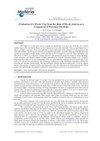Process of converting human hair into hollow carbon filament for electrochemical capacitor
IF 1.2
4区 材料科学
Q4 MATERIALS SCIENCE, MULTIDISCIPLINARY
引用次数: 1
Abstract
Carbon material is the largest material used as electrode on advanced energy storage devices. The modern lifestyle requires more energy, consequently, more smart energy use and efficient devices are needed. The constant evolution of materials technologies looking for green material and renewable raw material, that have minimal impact on the environment, is one of the most important subjects studied in recent years. The scientific and industry community are paying more attention to new forms of carbon such as nanotubes, graphene, and activated carbon fiber. The purpose of this work is to convert human hair into a hollow carbon filament to be used as a supercapacitor electrode. The human hair needs 3 stages to be converted into carbon filament: textile manufacture, oxidation, and carbonization. The electrochemical behavior was analyzed in a threeelectrode electrochemical cell system with 2 M of H2SO4 electrolyte medium. The behavior of the electrode was characterized electrochemically by galvanostatic charge/discharge curves, cyclic voltammetry, and electrochemical impedance spectroscopy, showing 163 F g-1 of a maximum value of specific capacitance. Keywords: Residue. Human hair. Felt. Carbon filament. Supercapacitor.将人发转化为电化学电容器用空心碳丝的工艺
碳材料是先进储能装置中使用最多的电极材料。现代生活方式需要更多的能源,因此需要更智能的能源使用和高效的设备。随着材料技术的不断发展,寻找对环境影响最小的绿色材料和可再生原料是近年来研究的重要课题之一。科学界和产业界正在关注纳米管、石墨烯、活性炭纤维等新型碳。这项工作的目的是将人的头发转化为空心碳丝,用作超级电容器电极。将人的头发转化为碳丝需要三个阶段:纺织、氧化和碳化。在以2 M H2SO4为电解介质的三电极电化学电池体系中,对其电化学行为进行了分析。通过恒流充放电曲线、循环伏安法和电化学阻抗谱对电极的行为进行了表征,其比电容最大值为163 F -1。关键词:残渣。人类的头发。的感受。碳丝。超级电容器。
本文章由计算机程序翻译,如有差异,请以英文原文为准。
求助全文
约1分钟内获得全文
求助全文
来源期刊

Materia-rio De Janeiro
MATERIALS SCIENCE, MULTIDISCIPLINARY-
CiteScore
1.00
自引率
25.00%
发文量
51
审稿时长
6 weeks
期刊介绍:
All the articles are submitted to a careful peer-reviewing evaluation process by the journal''s Editorial Board. The Editorial Board, reviewers and authors make use of a web based proprietary automated tool to deal with the reviewing procedures.the Revista Matéria''s article reviewing restricted access system - SEER. Authors are not informed about the identity of the reviewers.
 求助内容:
求助内容: 应助结果提醒方式:
应助结果提醒方式:


